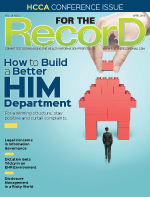April  2016
2016
Fresh Perspectives on Patient Engagement
By Bob Rossi
For The Record
Vol. 28 No. 4 P. 28
Patient engagement is emerging as a top priority in the health care community as growing evidence shows a strong link between more involved patients and improved outcomes. Meaningful use requirements and the US health care system's shift to a pay-for-performance model are two other driving forces behind this important development.
What's the state of patient engagement today? A recent study from CDW Healthcare, "Patient Engagement Perspectives" (available at www.cdw.com/patientengagement), takes the pulse of patients and providers on this vital issue. The study of 200 chronic patients (ie, those who had been to a doctor at least six times in the past year, excluding dental care) and 200 health care providers (ie, physicians and physician assistants at both ambulatory and inpatient US health care organizations/facilities) reveals encouraging progress, points to areas for further improvement, and provides new insight into the role of technology in helping to expand patient engagement.
Key findings include the following:
• Fifty-seven percent of patients say they have become more engaged with their health care during the past two years. Providers are noticing, as 70% have seen a change in their patients' level of engagement with their health care. When asked what motivated them to become more engaged, patients say greater communication with their health care provider (50%) is just as influential as a life event (50%).
• Sixty percent of providers say patient engagement is a top priority for them, but patients see things somewhat differently. Only 35% of patients say they have noticed their health care providers become more engaged with them.
• Both patients and providers see technology as a bridge to move forward; 74% of patients believe having greater online access to their personal health care information would help them take a more active role in their health care. Providers are in tune with this sentiment, as 60% say that providing patients with greater online access to their personal information would improve quality of care.
• Patients and providers agree on the two most valuable methods for encouraging patient engagement: Web-based access to general health care information (such as health care provider websites and resources from various condition-specific organizations, such as the American Cancer Society or American Diabetes Association) and online patient portals. Providers, however, see significantly greater value in mobile applications than patients. Meanwhile, patients see significantly greater value in online chat capabilities than providers.
• Providers are preparing for action, with 67% working on a way to make PHRs easier to access. Additionally, 28% of providers say they either provide or plan to provide patients with the ability to merge information stored on their mobile devices or wearable technologies with an online patient portal.
The Value of Patient Portals
Patient portals are a popular method for encouraging engagement, with 68% of providers saying patients at their practice can access a patient portal. Similarly, 60% of patients say they can access a patient portal, and of those who do not have access, 62% said they would use one if their health care provider gave them the ability to do so. However, portals do remain a work in progress. Providers report several barriers to establishing patient portals, including security concerns (41%) and cost (32%). Additionally providers are working to add top online features such as the ability to track self-care activities (23%), schedule appointments (21%), and view the cost of a visit/procedure (20%).
Generational Differences
The research also highlights several key differences when it comes to health care engagement by age. For example, respondents aged 18 to 49 are 19% more likely to say they face challenges when trying to engage with their health care than those older than age 50. This finding may be indicative of a growing expectation for anytime/anywhere connectivity among the younger cohort.
This contrast between age strata is especially clear when it comes to using technology as a channel for engagement. For example, 62% of patients between the ages of 18 and 49 say they use patient portals at least monthly vs 34% of those ages 50 and older. When it comes to submitting personal, real-time health care information to their health care provider, 57% of patients 65 or older would be willing to do so, compared with 76% of patients 18 to 29 years old.
Encouraging patient engagement is a perennial challenge, but one that providers can no longer afford to ignore. The good news is that patients welcome greater engagement, and both groups have more resources at their disposal than ever as we become an increasingly connected community. CDW Healthcare's "Patient Engagement Perspectives" report highlights the exciting future for patient engagement and HIT as providers find new and innovative ways to expand interaction with their patients through technology. This growing momentum behind patient engagement positions this trend to transform the health care industry and enable providers to focus on their top priority—improving patient care.
— Bob Rossi is vice president of CDW Healthcare.



